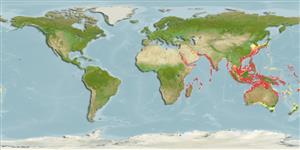Environment: milieu / Klimaatzone / Diepte / distribution range
Ecologie
marien rifbewoner; diepte 37 - 110 m (Ref. 11441). Tropical
Indo-West Pacific: Red Sea (Ref. 3141) and East Africa to Indonesia, north to southern Japan, south to northern Australia. Immigrated into the southeastern Mediterranean through the Suez Canal.
Grootte / Gewicht / Leeftijd
Maturiteit: Lm ? range ? - ? cm
Max length : 30.0 cm TL mannelijk / geslacht onbekend; (Ref. 9806); common length : 20.0 cm TL mannelijk / geslacht onbekend; (Ref. 9661)
Korte beschrijving
Determinatiesleutels | Morfologie | Morfometrie
Dorsale stekels (totaal) : 0; Dorsale zachte stralen (totaal) : 9; Anale stekels: 0; Anale zachte stralen: 9 - 10.
Body shape (shape guide): short and / or deep.
Inhabits deep coastal slopes and sheltered muddy substrates, usually in deep water offshore, but occasionally shallow near seagrass beds with silty rubble substrates (Ref. 48637). Usually occurs in sandy bottoms in coastal waters. Solitary (Ref. 90102). Feeds on benthic invertebrates. Generally considered as trash fish; not consumed. Its flesh and organs are poisonous (IUCN, http://www.iucnredlist.org/details/154933/0) however,
Levenscyclus en paargedrag
Maturiteit | Voortplanting | Paaien | Eieren | Fecunditeit | Larven
Matsuura, K., 2001. Ostraciidae. Boxfishes. p. 3948-3951. In K.E. Carpenter and V. Niem (eds.) FAO species identification guide for fishery purposes. The living marine resources of the Western Central Pacific. Vol. 6. Bony fishes part 4 (Labridae to Latimeriidae), estuarine crocodiles. FAO, Rome. (Ref. 9806)
Status op de Rode Lijst van het IUCN (Ref. 130435: Version 2025-1)
Gevaar voor de mens
Venomous
Gebruik door de mens
Visserij: van minder commercieel belang; Aquarium: Potentieel
Tools
Speciale rapporten
Download XML
Internetbronnen
Estimates based on models
Preferred temperature (Ref.
123201): 22.2 - 28.2, mean 26.9 °C (based on 480 cells).
Fylogenetische diversiteitsindex (Ref.
82804): PD
50 = 0.5625 [Uniqueness, from 0.5 = low to 2.0 = high].
Bayesian length-weight: a=0.04898 (0.02799 - 0.08571), b=2.74 (2.58 - 2.90), in cm total length, based on LWR estimates for this species & (Sub)family-body (Ref.
93245).
Trofisch niveau (Ref.
69278): 3.1 ±0.23 se; based on food items.
Weerstandsvermogen (Ref.
120179): Hoog, minimale populatieverdubbelingstijd minder dan 15 maanden (Fec assumed to be > 10,000).
Fishing Vulnerability (Ref.
59153): Low vulnerability (20 of 100).
🛈
Nutrients (Ref.
124155): Calcium = 44.1 [18.9, 108.3] mg/100g; Iron = 0.624 [0.321, 1.403] mg/100g; Protein = 18.3 [16.1, 20.4] %; Omega3 = 0.124 [0.064, 0.235] g/100g; Selenium = 42.6 [21.8, 87.9] μg/100g; VitaminA = 52.4 [15.2, 188.7] μg/100g; Zinc = 1.09 [0.74, 1.61] mg/100g (wet weight);
